Nice
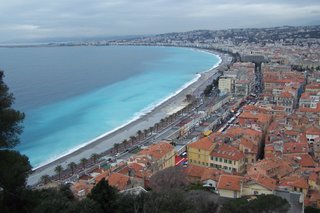
12 February 2007
Nice on a cloudy, rainy day was not as nice as Nice could be nice on a sparkling, sunny day. But Nice was still nice.
Facing the Mediterranean and backing onto the foothills of the French Alps, Nice dates well into antiquity with evidence of settlements in the Neolithic period. The Celtic Ligurians fortified the hilltop site. By the 3rd century BC, there is a Phoenician Greek trading site near the sea. By 1000 significant buildings of stone are found and a major fortified hilltop château and village appear by the 11th century. The castle passed into the hands of the Earl of Savoy in 1388. Partly ruined in the 17th century it was destroyed in 1706 by order of Louis XIV during the War of the Spanish Succession. In 1783 the site became the host to new cemeteries.
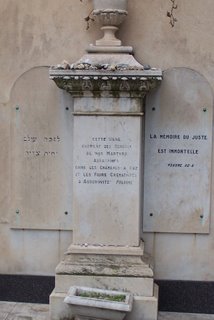 The Jewish cemetery contains ashes of some of the victims of the Holocaust.
The Jewish cemetery contains ashes of some of the victims of the Holocaust.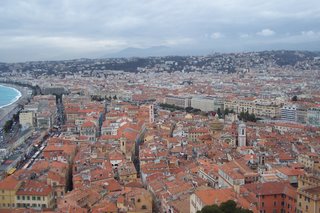 Today some of the hilltop ruins are undergoing archaeological excavation but its primary role is a viewpoint over modern seafront Nice and the Alps, hidden by cloud during our visit..
Today some of the hilltop ruins are undergoing archaeological excavation but its primary role is a viewpoint over modern seafront Nice and the Alps, hidden by cloud during our visit.. Two unusual sights while we were in Nice were the French Navy landing ship here as part of security arrangements for an an event in Cannes, a few miles west,
Two unusual sights while we were in Nice were the French Navy landing ship here as part of security arrangements for an an event in Cannes, a few miles west,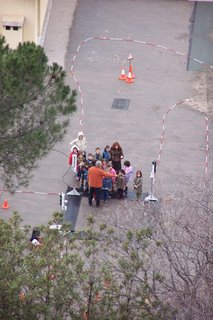 and children on the roof of their school being taught about traffic rules. Now that's effective use of space in a crowded old city.
and children on the roof of their school being taught about traffic rules. Now that's effective use of space in a crowded old city.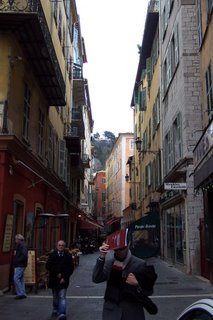 The so called “old town”, a labyrinth of narrow streets, is located on the lower slopes of castle hill. And look at that - rain can fall in narrow streets like this.
The so called “old town”, a labyrinth of narrow streets, is located on the lower slopes of castle hill. And look at that - rain can fall in narrow streets like this.Restaurants in France generally welcome dogs and this one in Nice is no exception.
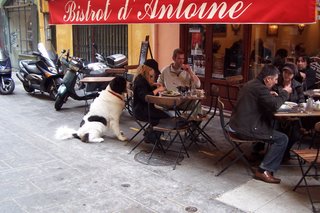
We’re not sure who eats the most food.
 A major tunnelling project in Nice was delayed with the discovery of extensive (at least a block long) stone ruins under the street.
A major tunnelling project in Nice was delayed with the discovery of extensive (at least a block long) stone ruins under the street.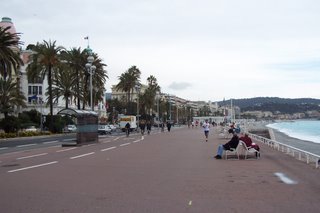 Nice is famous for its 7 km long Promenade des Anglais, now with a separate bike path (on the left). Like Hyer and Cannes, late 19th and early 20th century development depended heavily on the visits and investments of English Aristocracy and the royal family.
Nice is famous for its 7 km long Promenade des Anglais, now with a separate bike path (on the left). Like Hyer and Cannes, late 19th and early 20th century development depended heavily on the visits and investments of English Aristocracy and the royal family.A beautiful, wide “promenade” in a wonderful setting it is used today for strolling, roller blading, reading, gawking, and cycling. Across the road there is access to excellent shopping.
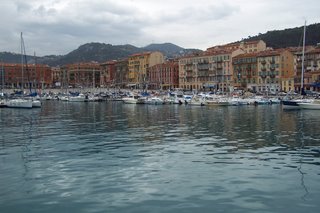 The old port although in the exact opposite corner of France, has the same feel as the much smaller port of St.-Valery-en-Caux in the northwest.
The old port although in the exact opposite corner of France, has the same feel as the much smaller port of St.-Valery-en-Caux in the northwest.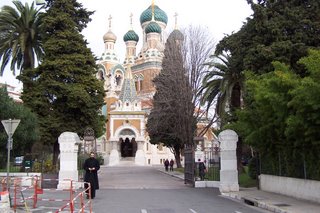 Nice also saw significant Russian immigration in the 19th century, resulting in the 1912 construction of the first Christian Orthodox Cathedral outside Russia.
Nice also saw significant Russian immigration in the 19th century, resulting in the 1912 construction of the first Christian Orthodox Cathedral outside Russia.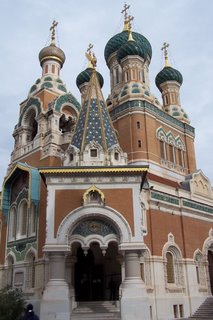
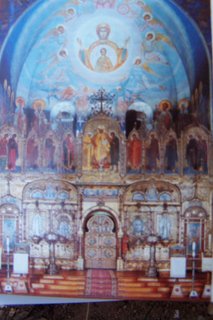
Interior photos are not allowed, so these are photos of purchased pictures.

Nice is a big and bustling city that still manages to keep vestiges of its past.


<< Home